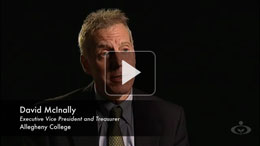Moving Beyond the Payback
By David McInally, Executive Vice President and Treasurer, Allegheny College
(This article appears in the September, 2011 issue of The ACUPCC Implementer)
Many colleges and universities have rightly celebrated the success of their first-generation sustainability efforts. Now that these initiatives have matured, the time has come for integrating them fully into institutional planning and financial systems, rather than relying primarily on arguments about economic paybacks.
Making the case for integration is relatively straightforward. Grass-roots efforts generally depend on individual champions, leading to uneven progress as campus leadership changes. Enthusiastic supporters may not be located in essential areas such as the budget, physical plant, or planning offices. Competition for resources can mean wavering commitment in times of scarcity.
 These potential obstacles become real threats for institutions that have relied too heavily on payback models. Rather than integrating sustainability fully into the organization’s strategic plan—where the goals are clearly stated and understood by the wider community—many colleges and universities have promoted sustainability as an initiative that pays for itself. This approach is an effective way to open the door for energy-reducing investments, but its limitations become apparent as soon as the fast-payback initiatives are completed.
These potential obstacles become real threats for institutions that have relied too heavily on payback models. Rather than integrating sustainability fully into the organization’s strategic plan—where the goals are clearly stated and understood by the wider community—many colleges and universities have promoted sustainability as an initiative that pays for itself. This approach is an effective way to open the door for energy-reducing investments, but its limitations become apparent as soon as the fast-payback initiatives are completed.
- Read more about Moving Beyond the Payback
- Add new comment








 The higher education sector in the US is responsible for many of the world’s most influential ideas, values, and leaders. With a critical mass of these institutions — nearly 700 strong, representing 6 million students — now making real progress towards climate neutrality, the ACUPCC is laying an important foundation in creating the clean, green economy.
The higher education sector in the US is responsible for many of the world’s most influential ideas, values, and leaders. With a critical mass of these institutions — nearly 700 strong, representing 6 million students — now making real progress towards climate neutrality, the ACUPCC is laying an important foundation in creating the clean, green economy.




